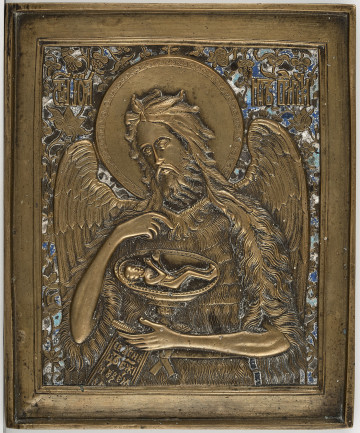
St. John the Baptist
20th century
Castle Museum in Łańcut
Part of the collection: Icons
Kazan Icon of the Mother of God Hodegetria Since the 16th c., the depiction of the Kazan Hodegetria became one of the most popular ones in Russia - see S.12770MŁ; copied in many domestic use icons decorated with metal coverings, like the displayed S.12773MŁ. The first icon of the Kazan Mother of God appeared to Matrona, the daughter of Daniel Onuchin, in dream visions, after the fire of Kazan. Nobody believed the girl, who ultimately persuaded her mother to dig through the charred remains of the parental house. On the depth of one metre, a painting done on a wooden canvas board was found. It was wrapped in a burnt-up caftan sleeve and shining "brighter than the sun". The painting depicted the Mother of God in half-figure, with Christ on the right side. At the behest of church authorities, the priest Yermolai transferred the image to the Church of St. Nicholas in a procession; at that time, the first miracle of healing a blind man was recorded. A copy of the miraculous icon was sent to Moscow, to Tsar Ivan IV the Terrible, who ordered the construction of a temple and a convent, which Matrona joined, on the site of the revelation in Kazan. The revelation of the icon helped strengthen the Orthodox Church on the territories of a former Islamic State, after the conquest of which the Russian Tsardom set out to conquer Syberia. The first such expedition was led from Kazan by the Cossack Ataman Yermak, carrying a copy of the Kazan Hodegetria to the east and contributing to the popularisation of the image in the farthest reaches of Syberia. The events related to the discovery of the painting and the witness statements about the first miracles are contained in a text written around 1594 by Yermolai, who entered a Moscow monastery and took the name Hermogen several years after the appearance of the icon; he returned to Kazan in 1589 as a bishop-metropolitan. Summoned by Tsar Vasili IV Shuisky , in 1606 he was ordained as the Moscow Patriarch at a time of a deep state crisis, which is described under S.12778MŁ. Teresa Bagińska-Żurawska https://orcid.org/0000-0002-9243-3967
Other names
Kazan Mother of God
Dimensions
height: 25 cm, width: 19.8 cm
Object type
Icons
Technique
gilding, metalloplastics, oil
Material
silver, brass, oil-based paint, wood
Origin / acquisition method
decyzja administracyjna
Creation time / dating
Creation / finding place
Owner
Castle Museum in Łańcut
Identification number
Location / status

20th century
Castle Museum in Łańcut

19th (?) century
Castle Museum in Łańcut

1800 — 1850
Castle Museum in Łańcut
DISCOVER this TOPIC
National Museum in Szczecin
DISCOVER this PATH
Educational path